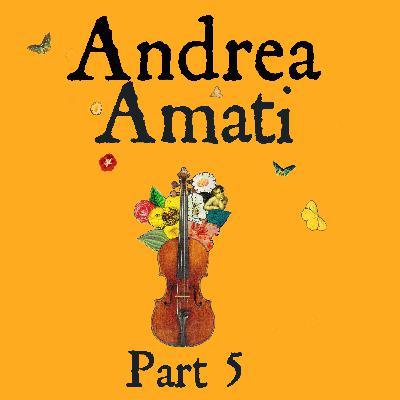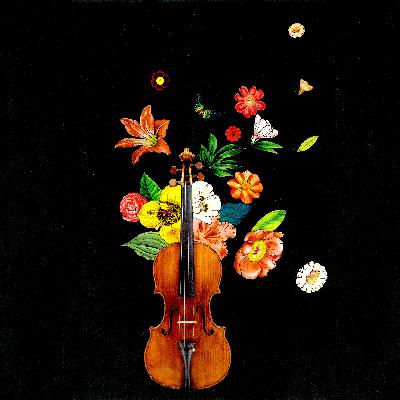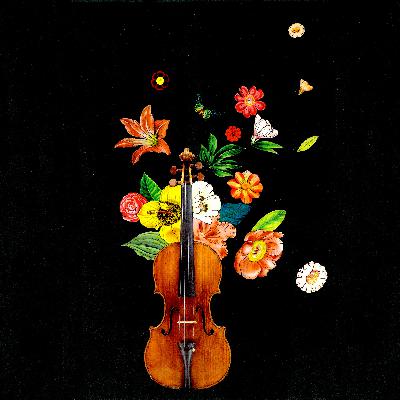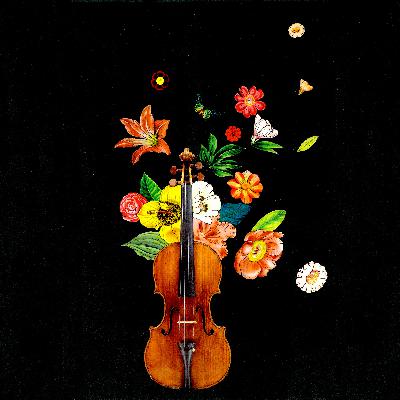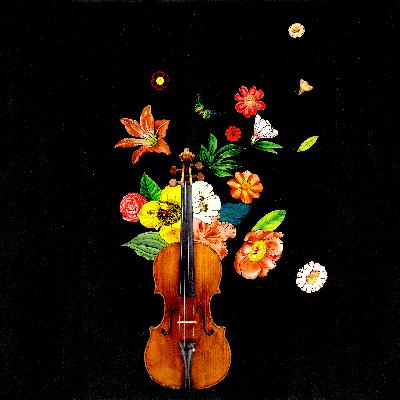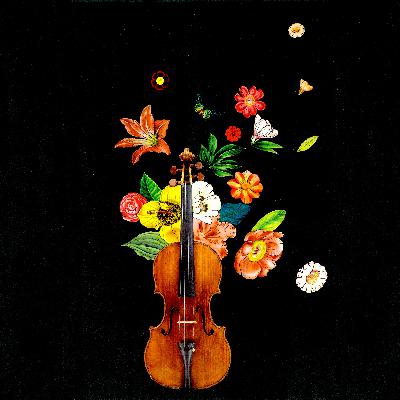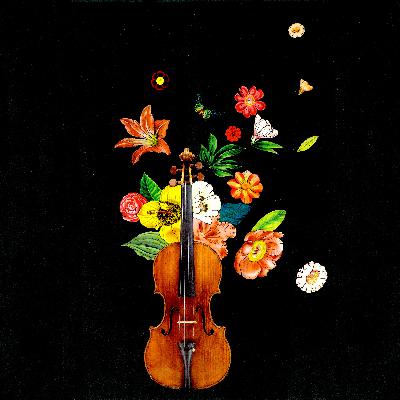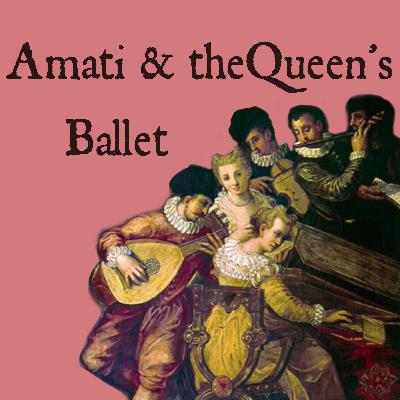Ep.8 Andrea Amati part 5 Is this the end of the violin?
Description
Andreas life is coming to an end, war is raging in France and fashion is dictating how you can hold your violin! Check it all out in this new episode.
As the violin making workshop of the Amatis in Cremona was in full swing, different members of the French royal family were trying not to get murdered as Henry of Navarre soon to be King Henry IV of France married Catherine de Medici’s daughter. In the City of Cremona already renowned for its violin makers we take a look at the different musicians and composers coming out of the cathedral school, Monteverdi being one of them, who would go to work at the famed Mantuan court, and the Amati Brothers taking on a pivotal role in the family violin workshop as Andrea enters old age continuing the family tradition.
Transcript
It is said that many years ago, the king Agilulf destroyed the city of Cremona, and that for the longest time it remained a pile of ruins, destined to be forgotten with the memory of its people crumbling to dust. But then one spring morning, a war weary Gaelic prince, encamped on the banks of the Po, with his army, near a pile of crumbling stone buildings. And it was there, as he was resting, that he saw an extraordinary sight. A lion, but this was no ordinary lion. It was limping and appeared to be in pain, unable to walk on one of its paws. The gallant and fearless prince approached the animal, and the beast, upon remarking the prince, showed him his injured paw, cut and bleeding, with a thorn sticking out of the wound.
The young man, showing not an inkling of fear, removed the thorn and healed the lion's soft paw. Just imagine the prince's surprise when a few hours later, the lion reappeared with a deer in his jaws. Padding forward, he offered his gift to the young man, laying his catch at the prince's feet as a gift.
The mysterious prince left with his army the very next morning, but as they were setting off, who should appear but the faithful lion, who would go on and follow him wherever he would go. When they reached Rome, the prince realized that the ruined city where he had encamped and met his beloved lion was the city of Cremona.
And so, as he made his way once again through the countryside, he headed for the ruins of this city. But tragically, on the way, his trusty lion died. And so, upon reaching the city, the Gaelic prince decided to rebuild Cremona. Firstly, he buried the lion, and on that spot, he built an incredibly tall tower, called the Torazzo.
This is the bell tower of the cathedral in Cremona. And on top of this tower, for a very long time, was a majestic bronze statue of a lion in the act of raising his paw towards the prince. A few centuries after the lion was placed on the tower, the bronze animal was melted down and fashioned into a large bell that was placed in the tower.
And as the bell rings, the memory of the faithful lion lives on. Today, there are at least 13 lions dotted along the facade of the baptistery, and more in front of the cathedral. Perhaps one of these fierce felines was the prince's faithful friend.
And this is the legend of the Lion of Cremona.
Hello and welcome to the Violin Chronicles, a podcast in which I, Linda Lespets, will attempt to bring to life the story surrounding famous, infamous, or just not very well known, but interesting violin makers of history. I'm a violin maker and restorer. I graduated from the French violin making school of Mirecourt some years ago now, and I currently live and work in Sydney with my husband Antoine, who is also a violin maker.
In the last episode of the Violin Chronicles, we looked at Andrea Amati perfecting the outline of the modern day violin and the French court under King Charles IX, Catherine de Medici's heavy influence as regent on her young son, and the significance of the images painted on the instruments ordered for the king, who was indeed a music loving monarch. And finally, the Amatis working methods that led in part to their success as instrument makers.
Almost five years after the royal tour, Andrea Amati is now 65. His place as a master instrument maker is undisputed. He has received orders from the King of France, no less. His production would have been different to that of violin makers today, in that he would have had to have been more flexible, making different sized and shaped instruments of the Renaissance era. He would have simply been following the fashion and client demand of the time.
I talked to fashion historian Dr. Emily Brayshaw about what people would have looked like back then and what musicians in particular would have worn.
So you've got farthingale sleeves on the men even, but and what it would do though is if you sort of look at these portraits of musicians and portraits of them playing instruments too, you can sort of get an idea of how they moved with that. So, you know, if you've got a massive ruff which is, you know, your 1580s fashion, you're not going to be sticking your instrument under your chin.
You know, there's too much ruff, there's too much lace, there's too much collar. So you might be holding it lower down, perhaps against your upper pecs. If it's a violin you'll be like playing it gamba style on, your lap, you know, or if they're bigger, got variations of them resting on the floor, these kinds of things.
So yeah, it's definitely going to be influencing how you're playing your instruments too. And then, the elbows as well, to be able to move your elbows. That's always an issue.
It is an issue.
Yeah, absolutely. It is an issue. And if you can, you sort of see photos of like these big farthingale sleeves, these slashed sleeves you know, big puffed sleeves, these kinds of things. You're not going to be raising your arms too high above your head. And certainly there would be outfits that they required movement in, you know, like if you're going into battle, you want full mobility or you're training for fighting or these sorts of things. So what's interesting in a lot of these illustrations is they're very idealized bodies coming from the art conventions of the Renaissance that were looking to classical Greek and Roman statues. And in portraits of the era, these shoulders are, we can see in these portraits, the neckline sits right down around the upper forearms particularly over the shoulder. Dress. Yeah, here we've got this here in a Mary Princess Royal portrait and we've got like this really low down cut down and it would have been very very difficult to raise your arms and your elbow, elbows would have been set right down and we see this a lot in like the Peter Lely portraits.
Yes, so there's a lovely portrait of a woman playing a gamba that we sort of see with that and she's got one of these gowns on and we see the shoulders sloping and falling again with menswear of the 1650s too. But yeah, these sloping shoulders that we're seeing in the 1650s would have contributed to that.
You know, the elbows being kept closer to the body, keeping your body front on, the instrument being held lower against the layers of fabric, and then playing like that, being everything being held close in. Yeah, yeah.
So the, the classic gamba playing posture would have worked.
Oh, would have worked perfectly.
Having to stick your elbows out or lift an instrument high just wouldn't have worked.
No, no, so that's why they're instruments. You know, we do still have pictures of violins being played quite low and held quite low.
And then there was often you would accompany yourself by singing and playing the violin.
Yeah, and you could do that because it's not tucked under your chin. So that's our 1605 kind of look there. Wow, I mean you've got a platform that you could rest your scones on.
Yeah, I mean I'd feel like if I was a man with all that fabric on, I would just feel like putting the instrument next to me, like it would just feel like a stretch holding it the way we do now?
Yeah, I think so, given that there were lots and lots of layers under these too, so you know, again, it's all part of the layering. And also, even though you don't have, like in the 1600s now, you don't have these massive, ruffs in most of Europe. The Dutch held on to the ruffs and these big sort of cartwheel collars for a lot longer than the rest of Europe.
You know, you've got what's known as a falling band, so the lace collars are coming down. You still do have a little bit of a rise on the collars as well. So you've still got, you know, like these collars would not have been necessarily ideal for holding your instrument against it so it's probably going to be held a bit lower, further down the, further down the shoulder.
And we see that in images too, you know, the images slung under the shoulder. All of this stuff was just mind bogglingly expensive. So not only would you have your portrait painted and that cost an absolute motza, you'd be wearing your absolute finest clothes for it.
Were you saying it was like half a million?
Like Oh, and the rest, like in today's money, in today's outfit would, yeah, just one outfit for the portrait that you're wearing would be half a million dollars plus all the other things that were often in your portrait as well. So they're kind of a bit like a selfie filter where you are. You know, flexing, showing your cash.
So, for example, you know, if you were there playing a gamba in a portrait or playing an instrument in a portrait you'd be showing that yes, you're musical, you're cultured, you're, you know, you're part of this, you know, this ideal humanistic world that values the humanities, but also you can afford One of these really expensive instruments too.
It's another layer of wealth.
It is another layer of wealth, yeah, and there's a lot of layers of wealth in

